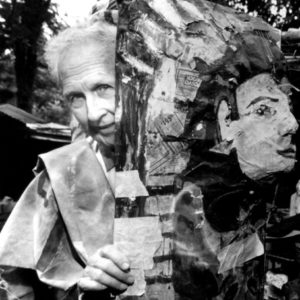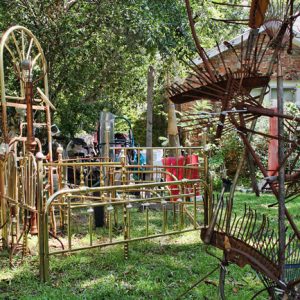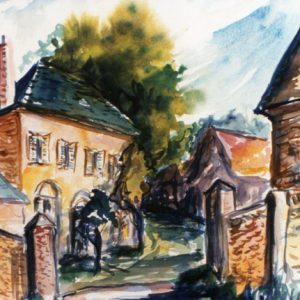calsfoundation@cals.org
Lester Gene Hatfield (1925–2017)
Lester Gene Hatfield was an artist and teacher closely associated with the University of Central Arkansas (UCA) and Conway (Faulkner County). He made paintings in watercolor, oil, acrylic, and sculpture. His best-known work was the transformation of the yard of his Conway home into an art environment, the result of more than forty years of working with junk and recycled objects. His sculpture combined aesthetic values from art movements such as surrealism with qualities of folk art, while his paintings and watercolors were done in the tradition of late-nineteenth-century artists such as Paul Cézanne. His long tenure as an art teacher at UCA was an important contribution to Arkansas’s art culture.
Gene Hatfield was born on November 23, 1925, in Conway to Lester Hatfield and Gertrude Powers Hatfield. He had three older sisters and one older brother. Growing up during the Depression in Conway and Mount Vernon (Faulkner County), Hatfield learned from his father—a house-building contractor—to be conservative and economical, and from his grandmother—whose yard was “a treasure chest of junk”—how to enjoy clutter. His interest in the arts was kindled and fueled by painting and putting on puppet shows in elementary school, by singing lessons, and by impromptu shows in the garage of the family house.
After graduating from Conway High School, he served in the U.S. Army in World War II; he was honorably discharged in 1944. He then attended Arkansas State Teachers College, majoring in speech and English with a minor in art (there was no major in art at the time). After receiving his BSE in 1948, he attended the Colorado State College of Education (now the University of Northern Colorado), earning a master’s in art education in 1948. He returned to Conway the same year to teach art at Arkansas State Teachers College, continuing through its transformation to the University of Central Arkansas, and remaining until he retired in 1985. Hatfield taught drawing, painting, sculpture, crafts, and design, as well as art history and art appreciation for both art majors and general education students. For about a decade, he also taught stagecraft in the theater department.
In 1955, Hatfield went on a tour of western Europe, the first of many trips to Europe. Back in Arkansas, he met Nicole A. Wable, a native of Douai, France, then studying on a Fulbright grant at the University of Arkansas (UA) in Fayetteville (Washington County). They married in 1957, and she became a professor of foreign language at UCA. They had three children.
The Hatfields visited Europe almost every summer during his teaching career. He studied with Henri Goetz in Fontainebleau and Paris, France; with Leo Marchutz in Aix-en-Provence; and at the Fuller Art Studio of Saint Ives, England. They inherited a house in the city of Le Touquet in Picardy, France, to which they returned annually; they named it “Phare Corner,” a pun on the French word for lighthouse, because the house was in the shadow of one. The city museum and local collectors obtained some of Hatfield’s work.
Informal scenes of urban and rural life in France and other parts of Europe provided the subjects for many watercolors produced during these trips. These works are in the tradition of the Impressionists and other later nineteenth-century figures such as Cézanne, an artist Hatfield particularly admired. His teacher, Marchutz, encouraged Hatfield to work in the style of the French painter Raoul Dufy; two watercolor scenes of Mont Sainte Victoire, a site important to Cézanne, are good examples of his work in this style (works currently part of the Gene Hatfield Art Collection held by the University of Central Arkansas Foundation).
He also regularly produced works in a variety of media in Conway. Collage, painting, and sculpture were the more traditional forms he used. The houses he owned in Conway became works of art themselves. Rental houses he owned contained rooms with differently patterned curtains and carpets, chandeliers from stage productions, and backyard sanctuaries of found objects. After 1962, his house on Donaghey Street became the focus of his sculptured work. Influenced by the surrealist artist Max Ernst, Hatfield used discarded materials and found objects, such as machine parts and mechanical objects, transforming them into figures, often with humorous results. He mixed and arranged, creating three-dimensional collages. Hatfield also worked in the tradition of artists whose use of discarded materials cast light on the wastefulness of contemporary society. His Dum Wayter (1987) combined things such as grills, cooling units, bottle racks, and dishes. Many of these works were photographed and registered as part of the Smithsonian Institution’s Save Outdoor Sculpture program.
In late 2002, Hatfield’s house and yard were subject to complaints and legal action by public officials. In the end, though not everyone appreciated his creative work, a legal ruling established its legitimacy as art, and the grounds of his home on Donaghey Street remained full of witty and engaging forms and figures, frequently visited by students, not only in art classes but also writing classes. After his 1985 retirement, he continued to work as an artist. He painted regularly with a class at UCA, exhibited work, and developed sculpture from the variety of materials he collected. He donated a large body of his own work and works by other artists to the University of Central Arkansas Foundation, including a portrait of his friend author Dee Brown. His work is also represented in public and private collections in Le Touquet, France; Eastbourne, England; Washington DC; Little Rock (Pulaski County); and Conway.
Hatfield published three novels: Enola Victrola: An Arkansas Adventure (self-published under the pseudonym Lester Retsel in 1987 and later republished as Naked Lies Enola by Colonial Press), The Devil’s Toupee: An Arkansas Misadventure (Conway, AR: River Road Press, 1989), and Chocolate Chicanery (Pittsburgh, PA: Dorrance Publishing, 1993). He published a book of poems called A Chance to Enchant in 1998.
Hatfield’s wife died in 2004. He sculpted a monument at the cemetery in Mount Vernon for her in 2008.
UCA purchased Hatfield’s home on the edge of campus in 2016 after Hatfield had moved to a retirement home. The house was torn down.
Hatfield died on February 18, 2017. In April, students from Carl Stuart Middle School under the direction of their teacher, Hatfield’s former student Becky Thorton, made sculptures and placed them on the lot where Hatfield’s home had been as a tribute.
For additional information:
Gene Hatfield University of Central Arkansas Archives and Special Collections, Conway, Arkansas. http://uca.edu/artcollection/gene-hatfield/ (accessed August 11, 2023).
Keith, Sonja. “Hatfield Remembered for His Art and Generosity.” Log Cabin Democrat, February 18, 2017. https://www.thecabin.net/archives/hatfield-remembered-for-his-art-and-generosity/article_afff8202-07e3-500e-976e-49147f073844.html (accessed August 11, 2023).
McGuire, Julie. “An Introduction to the Art of Gene Hatfield.” MA thesis, University of Arkansas at Little Rock, 1987.
Munck, Casey. “Conway’s Junk Artist Sees Treasure in Trash; Clash with City Didn’t Slow Him Down.” Arkansas Democrat-Gazette, October 31, 2004, pp. 1B, 5B.
Spencer, Christopher. “Conway Artist Ordered to Pay $250, Clear Junk from His Yard.” Arkansas Democrat-Gazette, January 18, 2003, p. 1A.
Floyd W. Martin
University of Arkansas at Little Rock
 Gene Hatfield
Gene Hatfield  Yard Art by Gene Hatfield
Yard Art by Gene Hatfield  Yard Art by Gene Hatfield
Yard Art by Gene Hatfield  Untitled Watercolor by Gene Hatfield
Untitled Watercolor by Gene Hatfield 




Comments
No comments on this entry yet.